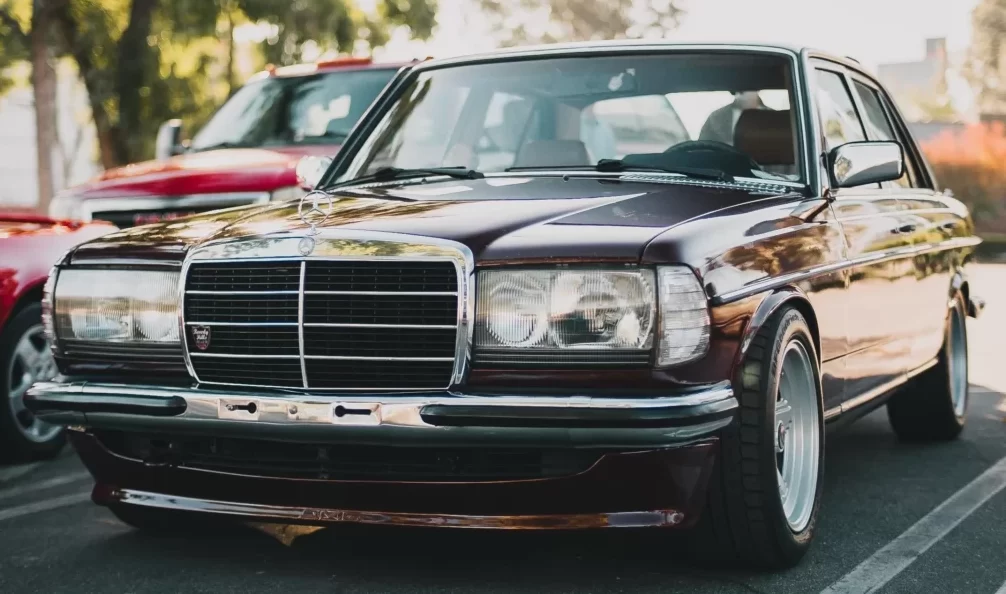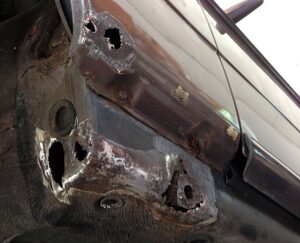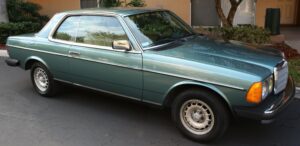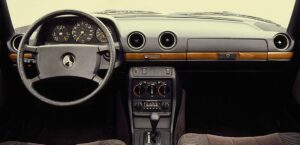Common problems with Mercedes W123
1. Corrosion – A Mercedes W123s worst enemy
2. Leaky door seals – A fairly common occurrence with the W123
3. Dashboard and instrument cluster issues
4. How reliable is the W123 Mercedes?
Corrosion – A Mercedes W123s worst enemy
Common problems with Mercedes W123. Mercedes W123 refers to a series of luxury cars produced by Mercedes-Benz from the mid-1970s to the mid-1980s. These cars are renowned for their robust build quality, engineering excellence, and longevity. However, like many vehicles from that era, one of the primary challenges they face is corrosion.
Corrosion, in the context of automobiles, generally refers to the gradual deterioration of metal components due to exposure to environmental factors such as moisture, salt, and other corrosive elements. For the Mercedes W123, which often featured extensive use of metal in its construction, especially in the chassis and body, this can be a particularly critical issue.
The term “worst enemy” underscores the severity of the problem. Corrosion can affect various aspects of the car, including the structural integrity of the chassis, the body panels, and other metal components. This not only compromises the aesthetic appeal of the vehicle but, more importantly, can lead to safety concerns and operational issues.
Owners of Mercedes W123 cars often face the challenge of dealing with rust, especially in regions with harsh climates or where roads are frequently treated with salt during winter. Preventive measures, such as regular inspections, rustproofing, and prompt treatment of any identified corrosion, are essential to mitigate the impact.
Leaky door seals – A fairly common occurrence with the W123
In this context, “leaky door seals” refers to problems with the rubber seals around the doors of the Mercedes W123. These seals play a crucial role in preventing water, dust, and noise from entering the vehicle’s interior. When they become worn or damaged over time, it can lead to water leaks during rain or when the car is washed.
This problem is not rare and is encountered by a notable number of W123 owners. The age of the W123 series, as these cars were manufactured primarily in the 1970s and 1980s, contributes to the likelihood of such issues arising due to wear and tear.
Addressing leaky door seals is important not only for the comfort of the occupants but also to prevent potential damage to the interior of the vehicle, such as carpeting or electronic components. Regular maintenance, inspection, and, if necessary, replacement of door seals are typical measures taken by owners to manage this issue and maintain the overall integrity of their Mercedes W123 cars.
Dashboard and instrument cluster issues
The “dashboard” is the panel located at the front of a vehicle’s interior, typically containing various controls, indicators, and displays. The “instrument cluster” is a specific part of the dashboard that houses various gauges, indicators, and, in modern vehicles, digital displays that provide essential information to the driver, such as speed, fuel level, and engine temperature.
Issues with the dashboard and instrument cluster can encompass a range of problems. This might include malfunctions or inaccuracies in the readings of gauges, problems with backlighting or display illumination, electrical issues affecting the functionality of indicators or warning lights, or even physical damage to the dashboard components.
For the Mercedes W123 electronic components and displays may be more susceptible to wear and aging. Common problems could include malfunctioning gauges, flickering lights, or issues with the overall functionality of the instrument cluster.
Addressing such issues typically involves diagnostics to identify the specific problem, and subsequent repairs or replacements as necessary. Restoring the proper functioning of the dashboard and instrument cluster is crucial for maintaining accurate information for the driver and ensuring the safe operation of the vehicle. Owners may seek the expertise of automotive technicians or specialists familiar with classic car restoration to address these concerns effectively.
How reliable is the W123 Mercedes?
Key factors contributing to the W123’s reputation for reliability include:
- Build Quality: The W123 was constructed with a robust body structure, featuring high-quality materials. The chassis and body panels were well-designed, contributing to the car’s overall durability.
- Engine Durability: The W123 was offered with a range of engines, including diesel options that gained particular acclaim for their reliability and fuel efficiency. The diesel models, in particular, are known for their longevity and ability to withstand high mileage.
- Simplicity in Design: The W123 was designed with a relatively simple layout. This simplicity often translates to ease of maintenance and repair, contributing to its long-term reliability.
- Attention to Rust Prevention: While the W123 is not immune to rust, Mercedes-Benz took measures to incorporate rust prevention into the design, helping to mitigate corrosion issues that commonly affect vehicles of that era.
- Timeless Design: The classic and timeless design of the W123 has contributed to its longevity. Well-maintained examples still enjoy a strong following among collectors and enthusiasts.
However, it’s important to note that the reliability of any specific W123 depends on factors such as maintenance history, driving conditions, and how well the car has been cared for over the years. As these cars are now considered classics, finding one in good condition often involves attention to maintenance and potential restoration.
In summary, the Mercedes-Benz W123 is generally considered highly reliable, and its reputation for durability has contributed to its status as a classic and sought-after model among automotive enthusiasts.
Are you already a proud owner of a Mercedes W123? If so, check out our selection of parts for this car at the following link:
https://octoclassic.com/product-category/mercedes-benz/w123
Photos sources: pinterest.de, Pinterest, workshoprepairmanual.com.au, Reddit











